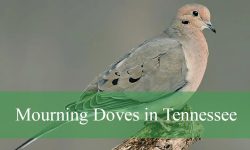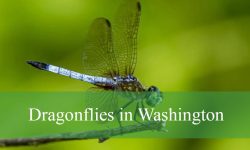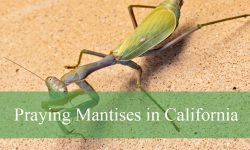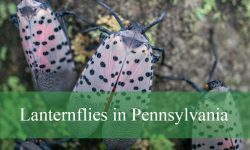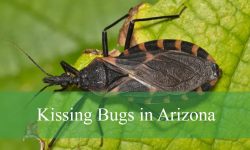Pennsylvania is home to many fascinating brown birds that blend naturally into their surroundings. These birds vary in size and markings, making them interesting to spot and identify. Watching brown birds in Pennsylvania offers great enjoyment for both new and experienced birdwatchers.
The brown birds in Pennsylvania include songbirds, hawks, and ground feeders. Some live in the state all year, while others come during migration or winter. Their brown feathers help them hide in forests, fields, and wetlands found throughout Pennsylvania.
This article lists 30 brown birds in Pennsylvania, with pictures and identification tips. It provides useful information to help you recognize these birds and understand their habits and habitats.
Common Brown Birds in Pennsylvania
House Sparrow (Passer domesticus)
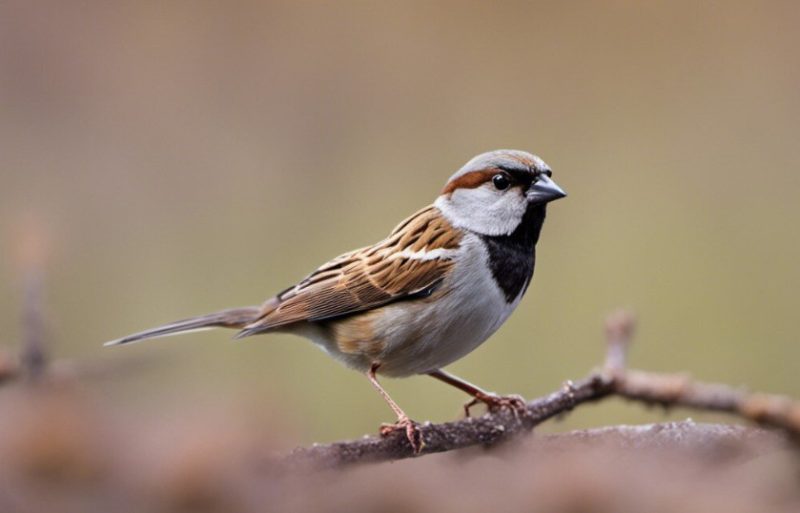
The House Sparrow is a small, stocky bird commonly found throughout Pennsylvania, particularly in urban and suburban neighborhoods. Males are easy to recognize with their gray heads, black bibs, and chestnut necks, while females have a more subtle appearance, with overall brown-gray plumage, a pale eyebrow stripe, and streaked backs. Measuring around 6 inches in length with short legs and a thick beak, they are perfectly adapted to life near people and can often be seen hopping along sidewalks, perched on fences, or pecking at crumbs in outdoor eateries.
This species is highly vocal, producing a repetitive and sharp “chirrup” that is familiar in many backyards and city parks. House Sparrows are social birds, often seen in flocks, especially outside of the breeding season. They are cavity nesters, building their nests in crevices of buildings, roof vents, and streetlights. Males aggressively defend nest sites and often stay close to their mates throughout the season. Their nesting materials include grasses, paper, feathers, and even plastic, reflecting their adaptability in human environments.
In Pennsylvania, House Sparrows are permanent residents and can be found year-round across the state. Their diet consists of a wide range of seeds, grains, and discarded human food, though they may also eat insects during the breeding season to feed their young. Their close association with people has helped them thrive, but their aggressive nesting habits can displace native cavity-nesting birds. They are especially abundant in cities like Philadelphia, Pittsburgh, and Harrisburg, as well as in rural towns and farms.
Song Sparrow (Melospiza melodia)
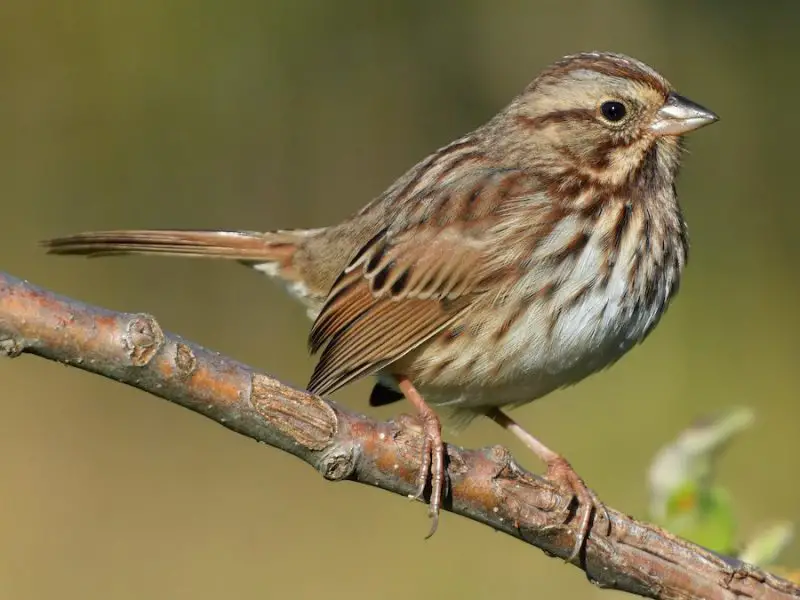
The Song Sparrow is a widespread and easily recognized brown bird with bold streaking across its chest and a distinct central breast spot. It has a rounded head, a short but notched tail, and a heavily streaked back with reddish-brown and gray hues. Adults average 5.5 to 6.7 inches in length and have a slightly long bill that helps in foraging. Though variable in appearance depending on the region, most Song Sparrows in Pennsylvania have warm brown upperparts and whitish underparts with dark streaks.
Known for their sweet and complex songs, males perch on shrubs and trees to sing a series of clear, whistled notes followed by buzzy or trilled phrases, especially in spring and summer. These vocalizations serve both territorial and mating purposes. Song Sparrows are generally solitary or found in pairs during the breeding season, but may gather in small groups during migration or winter. They build cup-shaped nests low in shrubs or grasses and are active foragers, often seen hopping on the ground or scratching through leaf litter.
In Pennsylvania, Song Sparrows are year-round residents, commonly seen in open fields, forest edges, marshes, and suburban gardens. They adapt well to human-altered landscapes and are often attracted to backyard feeders, especially if there’s dense cover nearby. Their diet is diverse, consisting of seeds, insects, and spiders. During breeding season, they rely more heavily on protein-rich insects, while in colder months they shift to seeds and grains. Their adaptability and sweet, consistent singing make them a familiar presence in most parts of the state.
Carolina Wren (Thryothorus ludovicianus)

The Carolina Wren is a small but energetic bird with a rich, reddish-brown back, buff-colored underparts, and a bold white eyebrow stripe that gives it a distinctive look. Measuring around 4.7 to 5.5 inches long, this chunky bird has a slightly curved bill and a short tail that is often held upright. Its appearance and behavior make it easy to spot in thickets, brushy backyards, and forest edges throughout Pennsylvania. Unlike some other wrens, both sexes look alike and are equally vocal.
This species is famous for its loud, cheerful song, often described as “teakettle-teakettle-teakettle” or “cheery-cheery-cheery.” Males sing year-round, and their song can be heard echoing from shrubs, fences, or woodpiles. Carolina Wrens are curious and bold, frequently exploring garages, porches, and flowerpots in search of nesting sites. They build dome-shaped nests from twigs, leaves, moss, and feathers. These wrens are also acrobatic foragers, often seen hopping along tree trunks or probing bark crevices for insects.
In Pennsylvania, the Carolina Wren is a year-round resident, though its numbers may drop during harsh winters. It prefers wooded suburban neighborhoods, overgrown fields, and dense forest undergrowth, especially where thick vegetation provides shelter. Its diet includes insects, spiders, and small invertebrates, though it may also visit suet feeders in cold weather. While once more common in the southern parts of the state, it has expanded its range northward due to milder winters and increased availability of human-made shelter.
House Finch (Haemorhous mexicanus)
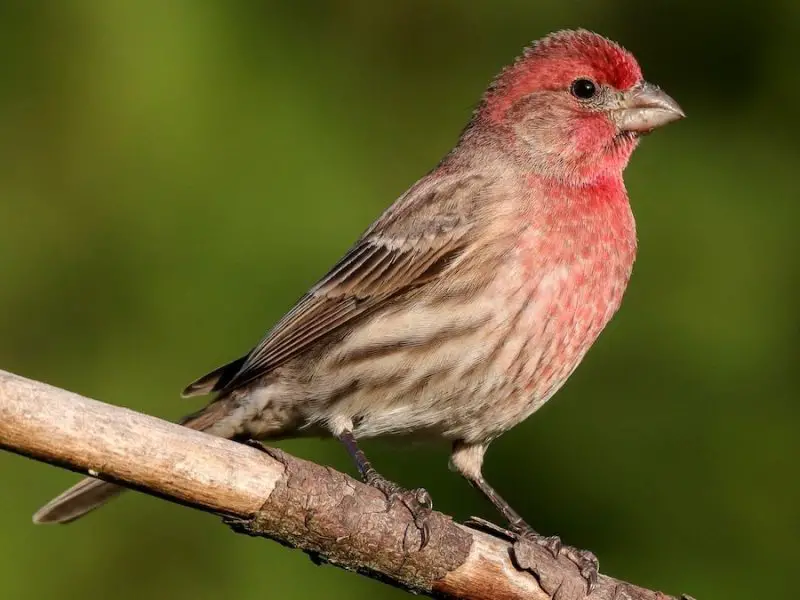
The House Finch is a small, sociable songbird with a conical bill and a cheerful demeanor. Males are bright red around the head and chest, while females are entirely brown with streaked underparts and plainer faces. Both sexes have slightly notched tails and measure around 5 to 6 inches in length. Though native to the western United States, they have successfully spread across Pennsylvania and are now common visitors to bird feeders and urban green spaces.
Their song is a pleasant, warbling mix of notes often ending in a harsh “cheep.” House Finches are highly vocal and often sing from rooftops, trees, or telephone wires. They are monogamous, and pairs remain close throughout the year. Nests are commonly built in building crevices, hanging planters, or even wreaths on doors. These birds are very tolerant of human activity and are usually not shy, making them easy to observe up close.
In Pennsylvania, House Finches are permanent residents and thrive in residential areas, parks, and farmlands. Their diet consists primarily of seeds, fruits, and buds, and they readily visit bird feeders filled with sunflower seeds. Females may also feed on small insects during the breeding season. House Finches are more adaptable than many native species and have become one of the most frequently observed birds in suburban Pennsylvania, especially in cities like Allentown, Erie, and Lancaster.
Red-winged Blackbird (Agelaius phoeniceus)
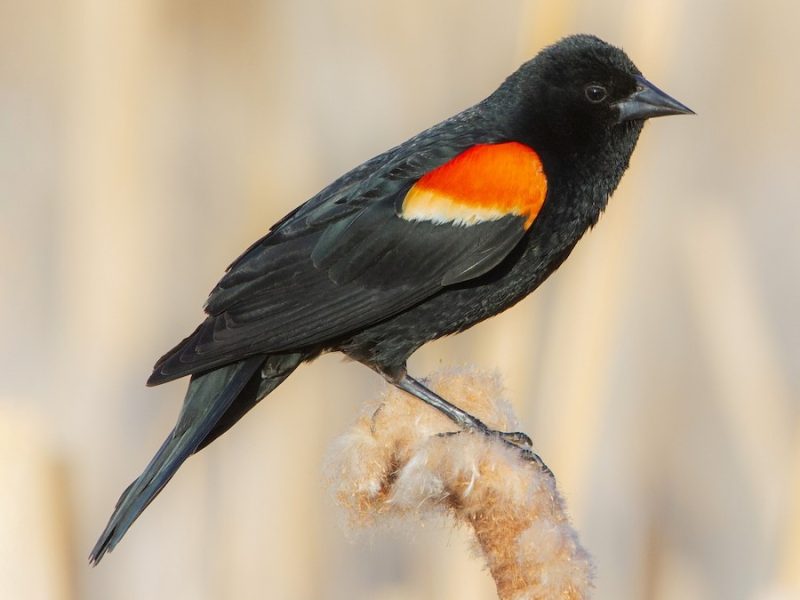
The Red-winged Blackbird is one of the most recognizable wetland birds in Pennsylvania, especially the males with their striking black bodies and bright red-and-yellow shoulder patches. Females, however, are very different in appearance—they are brown and heavily streaked, resembling large sparrows. Females measure about 6.5 to 7 inches in length and have a long, slender bill, pale eyebrow stripe, and streaked underparts, making them more camouflaged in grassy or marshy environments.
Red-winged Blackbirds are known for their distinct “conk-la-ree!” call, which males use to defend their territory during breeding season. These birds nest in colonies, often in cattails or shrubs close to water, and are fiercely protective of their nests, chasing away much larger animals and even humans. Females build the nests and incubate the eggs while the males patrol nearby. Outside the breeding season, large flocks of Red-winged Blackbirds may gather with grackles, starlings, and cowbirds.
In Pennsylvania, Red-winged Blackbirds are abundant in spring and summer, particularly in wetlands, marshes, and fields. Some individuals may stay through winter in southern parts of the state, but most migrate south. Their diet includes insects during the breeding season and seeds and grains in fall and winter. Females forage on the ground or in low vegetation and are less conspicuous than males but just as vital to the species’ success. Their presence in rural and suburban marshlands is a strong indicator of healthy wetland ecosystems.
Chipping Sparrow (Spizella passerina)
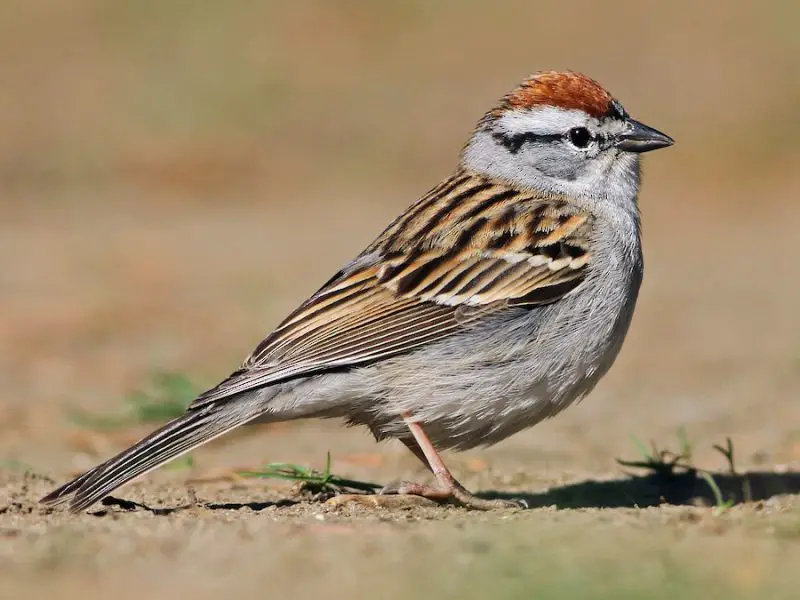
The Chipping Sparrow is a small, graceful bird with a lightly streaked brown back, pale gray underparts, and a clean black line through the eye. During the breeding season, it becomes especially distinctive thanks to its bright rusty-red crown, which contrasts with its clear face and slender build. This species measures about 5 inches in length and has a slightly notched tail, a fine, pointed bill, and a smooth, rounded head.
Chipping Sparrows are known for their dry, mechanical-sounding trill, often heard throughout the spring and summer in Pennsylvania. Males typically sing from the tops of small trees, shrubs, or fences to establish territory and attract a mate. These birds nest in open woodlands, forest edges, parks, and yards with scattered trees and shrubs. Their nests are small cups made of grasses and rootlets, often placed in conifers or ornamental trees.
In Pennsylvania, Chipping Sparrows are common summer residents, arriving in early spring and departing by late fall. They are often seen hopping on the ground in search of seeds or perching in bushes near homes and gardens. Their diet includes grass seeds, small grains, and a variety of insects during the breeding season. Though plain at first glance, their tidy appearance and cheerful presence make them a welcome sight in many Pennsylvania backyards.
Brown-headed Cowbird (Molothrus ater)

The female Brown-headed Cowbird is a medium-sized, stocky bird with a uniform brownish-gray coloration and a short, thick bill. While the male is glossy black with a rich brown head, the female is more subdued, with a smooth, unmarked body that helps her remain inconspicuous when searching for nests to parasitize. She lacks streaking or bold facial markings, making her appear rather plain, though this simplicity is part of her camouflage.
Brown-headed Cowbirds are well known for their unusual nesting strategy: instead of building their own nests, females lay their eggs in the nests of other bird species. Once the egg hatches, the cowbird chick is usually raised by the unsuspecting host parents, often at the expense of their own young. Female cowbirds are frequently seen in open habitats such as fields, pastures, and lawns, where they follow other birds and watch for nesting activity.
In Pennsylvania, this species is a widespread summer resident, especially common in agricultural areas, woodland edges, and suburbs. Their diet consists mainly of seeds and insects, and they frequently visit ground feeders alongside other blackbirds and sparrows. Though their brood parasitism may be harmful to some native birds, Brown-headed Cowbirds play a natural role in the avian ecosystem, and their behavior is fascinating to observe.
White-throated Sparrow (Zonotrichia albicollis)

The White-throated Sparrow is a chunky, medium-sized sparrow with a striking facial pattern and a distinctive white patch on its throat. The back and wings are warm brown with black streaks, while the underparts are gray. One of its most recognizable features is the yellow spot between the eye and bill, along with two broad stripes on the head—either black and white or brown and tan, depending on the color morph. Both morphs are common in Pennsylvania.
This sparrow is well known for its melodic song, which sounds like “Oh-sweet-Canada-Canada” and is often repeated during spring and fall. It forages on the ground, usually in flocks, kicking aside leaves in search of seeds, berries, and insects. White-throated Sparrows are shy but will come close to feeders, especially if there is dense shrubbery or brush nearby for cover. During colder months, they may join mixed flocks with juncos, cardinals, and other sparrows.
In Pennsylvania, White-throated Sparrows are mostly winter residents, arriving in late fall and remaining until early spring. They are especially common in wooded suburban yards, forest edges, and thickets. Their calm behavior, eye-catching markings, and sweet whistles make them one of the most beloved winter sparrows in the state.
Mourning Dove (Zenaida macroura)
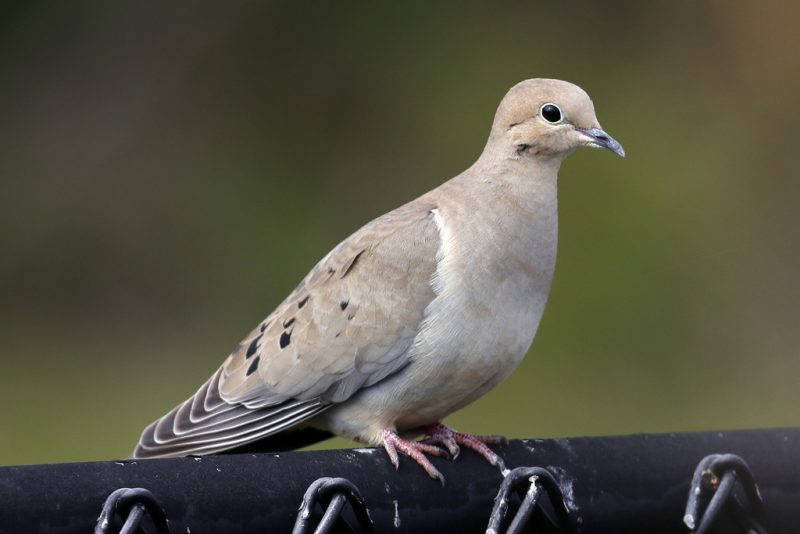
The Mourning Dove is a sleek, medium-sized bird with soft brownish-gray plumage, a small, rounded head, and a long pointed tail edged in white. Its delicate appearance is matched by its gentle personality and low, mournful cooing calls, which sound like “oo-AH-oo-oo-oo.” Black spots on the wings and a subtle pink wash on the chest add a touch of elegance to this widespread species.
These doves are often seen perched on telephone wires, rooftops, or tree branches, especially in the early morning or evening. They walk on the ground with a gentle, bobbing motion, often searching for seeds under feeders or near grain fields. Mourning Doves build flimsy, shallow nests in trees, shrubs, or even on balconies and ledges. Pairs often stay together for life and raise multiple broods each season, especially in warmer months.
In Pennsylvania, Mourning Doves are permanent residents and among the most familiar birds across both rural and urban areas. Their diet consists almost entirely of seeds and grains, which they swallow whole and later grind in their gizzards. Despite their calm demeanor, they are strong fliers and can take off rapidly with a whistling sound from their wings. Their peaceful presence and soothing calls make them a comforting and common sight in gardens and open spaces.
House Wren (Troglodytes aedon)
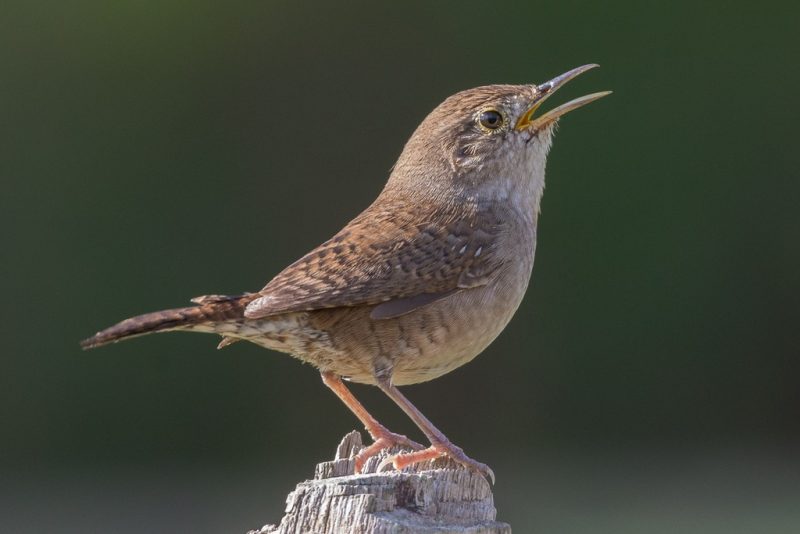
The House Wren is a small, compact bird with rich brown plumage, a faintly barred tail, and a pale throat and chest. It has a thin, slightly curved bill and often holds its short tail upright as it flits through shrubs and low branches. Though it lacks bright coloration or bold markings, its active behavior and loud, bubbling song make it one of the easiest small brown birds to recognize during summer.
This species is highly energetic and territorial, often seen hopping among tree branches, garden trellises, and backyard furniture in search of insects or nesting sites. House Wrens build their nests in cavities, including nest boxes, old woodpecker holes, or openings in sheds and porches. They weave intricate, domed nests out of twigs, feathers, and grasses, and are known to fill nearby cavities with sticks to keep out competitors.
In Pennsylvania, House Wrens are common summer residents, arriving in April and staying through early fall. They are especially fond of yards with mature trees, dense shrubs, and available nest boxes. Their diet includes beetles, caterpillars, spiders, and other small invertebrates, making them valuable garden allies. Though small and plain in appearance, their bold attitude and musical chatter ensure they’re noticed wherever they live.
American Robin (Turdus migratorius)
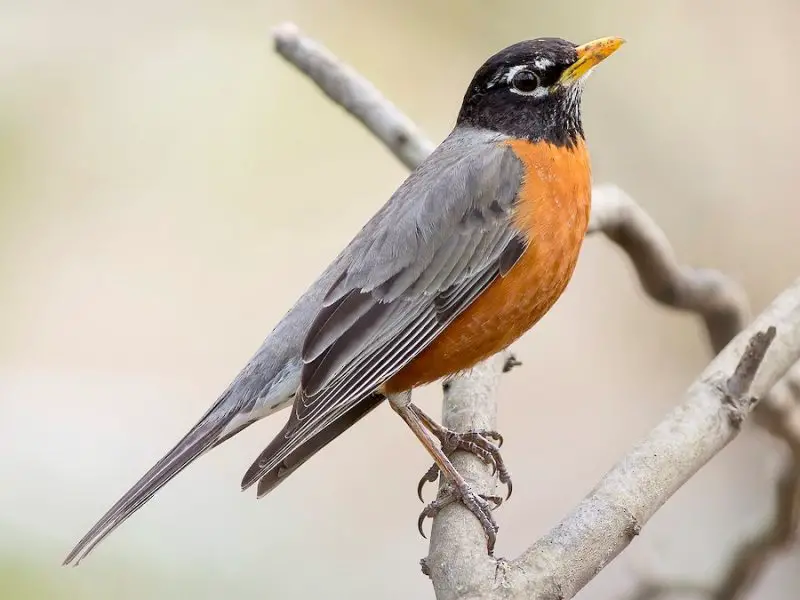
The American Robin is a well-known bird across North America, easily recognized by its bright orange-red breast, but its upperparts—including the head, back, and wings—are a rich brown or grayish-brown, making it relevant among partly brown species. It has a white throat streaked with black, a yellow bill, and a rounded body that stands out on lawns and open ground. Measuring about 10 inches long, this thrush is larger than most backyard birds.
Robins are often seen hopping across lawns, pausing with heads tilted as they listen for earthworms beneath the soil. They also feed on fruits, berries, and insects, especially during the breeding season. Their song is a cheerful series of clear whistles, commonly heard early in the morning and during twilight hours. Robins build sturdy, mud-lined nests in trees, shrubs, and even on human structures, laying up to three broods per season.
In Pennsylvania, American Robins are abundant year-round in many areas, though northern populations migrate south in winter. They are among the earliest signs of spring, returning as soon as the ground begins to thaw. Although their orange belly is most striking, the brown tones of their back and head give them a classic woodland look, blending well into forest edges, city parks, and backyards.
Winter Wren (Troglodytes hiemalis)

The Winter Wren is a tiny, round-bodied bird with deep chocolate-brown plumage, heavily barred wings and tail, and a pale eyebrow stripe. It has a very short tail that is often held upright, giving it a perky appearance. At only about 4 inches long, it is one of the smallest birds in Pennsylvania, yet its behavior and voice make it remarkably noticeable when present.
This wren is known for its explosive, cascading song—a surprisingly long and complex series of trills and whistles that echoes through quiet forests in late winter and spring. It prefers dense undergrowth, fallen logs, and tangled brush piles, often foraging low to the ground for insects and spiders. Winter Wrens move quickly and prefer shadowy habitats, often flicking their wings and tail while creeping through low branches or roots.
In Pennsylvania, Winter Wrens are primarily winter residents, though some may breed in the northern or higher elevation forests. They favor mature woods with dense cover and moisture, especially near streams and ravines. Despite their shy nature, they are a delight to encounter due to their rich vocalizations and hyperactive movements through the leaf litter.
Brown Creeper (Certhia americana)
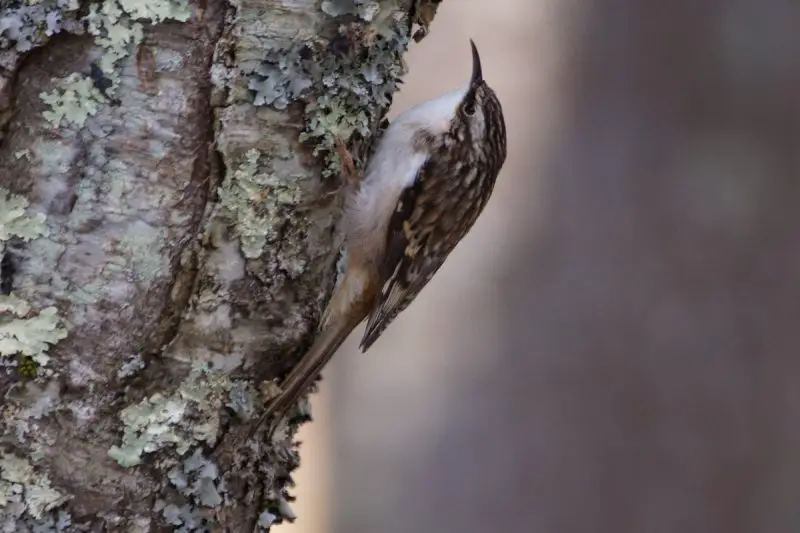
The Brown Creeper is a slender, secretive songbird with cryptic brown-and-white plumage that closely mimics tree bark. It has a streaked brown back, a long stiff tail used for support, and a thin downcurved bill adapted for probing into bark crevices. The underparts are pale, and its overall pattern provides excellent camouflage against tree trunks. At about 5 inches in length, it is easy to overlook despite its unique foraging behavior.
This species moves in a spiraling, upward path along tree trunks, silently searching for insects, larvae, and spiders. Once it reaches a high point, it flies to the base of another tree and begins again. Its song is a high-pitched, lisping melody that’s often heard in early spring. Brown Creepers nest behind loose bark or in natural crevices of dead trees, using moss and spider silk to construct their hidden nests.
In Pennsylvania, Brown Creepers are year-round residents in mature woodlands, especially where there are large, old trees. They can be found in both coniferous and mixed forests, though they are more active and visible in the cooler months. Their bark-colored appearance and unique tree-climbing habit make them a fascinating, if elusive, member of Pennsylvania’s brown bird community.
Eastern Towhee (Pipilo erythrophthalmus)
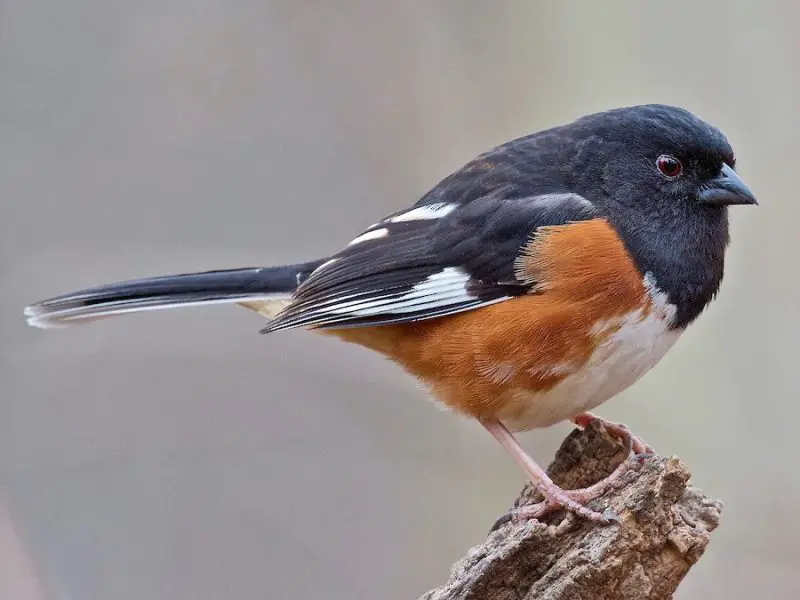
The Eastern Towhee is a strikingly patterned sparrow, with males showing bold black, white, and rufous colors, while females have a warm chocolate-brown where the males are black. Both sexes share the same rusty flanks, white belly, and thick, conical bill. Measuring about 8 inches long, this bird has a thick tail with white outer feathers, often flicked as it moves through the brush.
Towhees are often heard before they’re seen, scratching loudly in leaf litter under shrubs and forest edges in search of insects, seeds, and berries. They make a distinctive two-note call that sounds like “chewink” and sing a whistled phrase often described as “drink your teeeee.” Eastern Towhees nest close to the ground in dense vegetation, often hidden under thick tangles of branches or vines.
In Pennsylvania, Eastern Towhees are common summer residents and are particularly abundant in overgrown fields, forest edges, and clearings. They may also stay through the winter in southern parts of the state where cover is available. Female towhees, with their rich brown coloration and habit of rummaging noisily through leaves, are a familiar and welcome presence in shrubby habitats.
Savannah Sparrow (Passerculus sandwichensis)
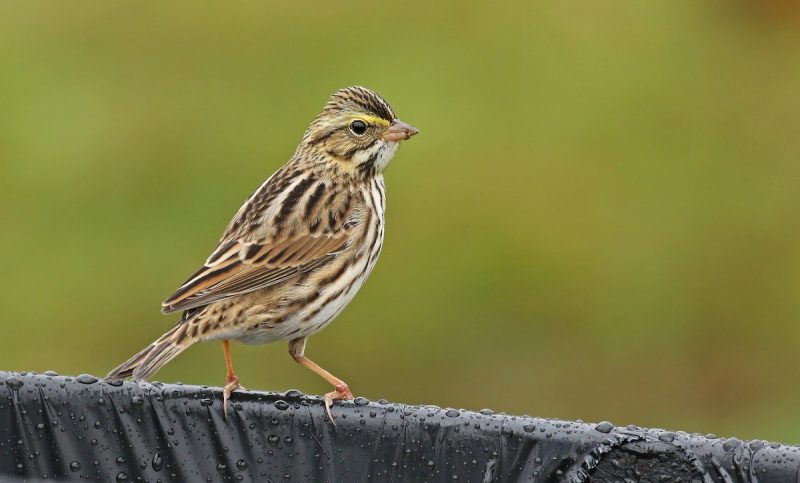
The Savannah Sparrow is a medium-small, streaky brown bird with a short tail and distinctive yellowish eyebrow stripe above the eye. Its back and wings are brown with darker streaks, while the underparts are pale with fine brown striping across the chest and flanks. It has a notched tail and a small, pointed bill, well suited for seed-eating. This sparrow typically measures around 5.5 inches long.
Savannah Sparrows are ground-dwellers, often seen foraging in open grassy areas, meadows, and agricultural fields. They fly in short, fluttering bursts, often diving into tall grasses when disturbed. Their song is a high, buzzy phrase that ends in a sharp trill. During the breeding season, males sing from fence posts or tall weeds to defend territory. In winter, they form loose flocks and feed on seeds, often in weedy fields and roadside edges.
In Pennsylvania, Savannah Sparrows are seen mostly during migration and in winter, though they may breed in open northern areas. They favor flat, open landscapes with low vegetation. Though not as showy as some other sparrows, their yellow face stripe and crisp patterning help birdwatchers distinguish them in the field. Their preference for grassland habitats makes them an important species in farmland and prairie restoration areas.
Swamp Sparrow (Melospiza georgiana)
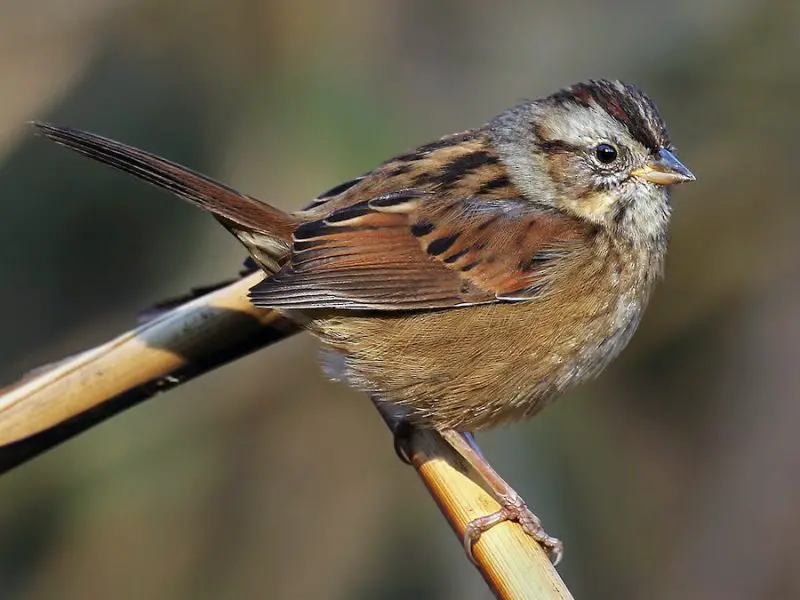
The Swamp Sparrow is a medium-sized sparrow with a dark brown back streaked with black, a grayish breast, and a rufous cap that becomes more prominent in breeding season. It also has a short, stout bill and clean, unmarked underparts, which help distinguish it from other streaky sparrows. The wings often show reddish-brown tones, adding subtle richness to its earthy plumage.
This species is most often found in wetlands, where it favors cattail marshes, sedge meadows, and wet thickets. It prefers dense, damp vegetation where it can forage for seeds, insects, and aquatic invertebrates, often close to the ground or water’s edge. The Swamp Sparrow’s song is a slow, musical trill, softer and more melodic than many of its relatives. It sings from low perches like reed stalks or shrubs within its marshy habitat.
In Pennsylvania, the Swamp Sparrow is a fairly common breeder in wetlands during the summer and can also be found during migration and in some cases through winter, especially in the southern part of the state. Its strong association with marshes makes it a good indicator of healthy wetland ecosystems, and though not always easy to spot, its presence is often revealed by its sweet, trilling voice.
Field Sparrow (Spizella pusilla)
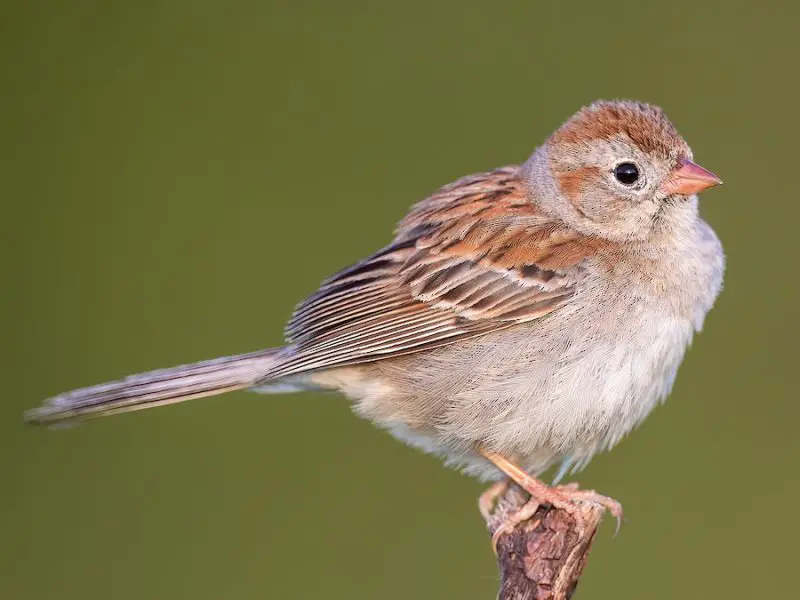
The Field Sparrow is a delicate-looking bird with soft, pale brown upperparts and a faint pinkish wash to its face and sides. Its most notable features are its large, dark eyes and pink bill, giving it an innocent expression. The crown and back show fine streaking, but the chest and belly are clean and unmarked, helping it stand out from other streaky sparrows.
This species prefers open grassy habitats with scattered shrubs, such as old fields, overgrown pastures, and meadow edges. It often sings from fence posts or small trees, delivering a clear, accelerating series of whistles that sounds like a bouncing ball. Field Sparrows nest close to the ground in grassy clumps or low shrubs, where their camouflaged plumage provides excellent protection.
In Pennsylvania, Field Sparrows are common summer residents throughout the state and are especially prevalent in areas with shrubby grassland. Their numbers have declined in regions where open fields are being lost to development or reforestation. Nonetheless, their soft brown colors, distinctive song, and preference for sunny open spaces make them a cherished part of the summer birdlife.
Wood Thrush (Hylocichla mustelina)
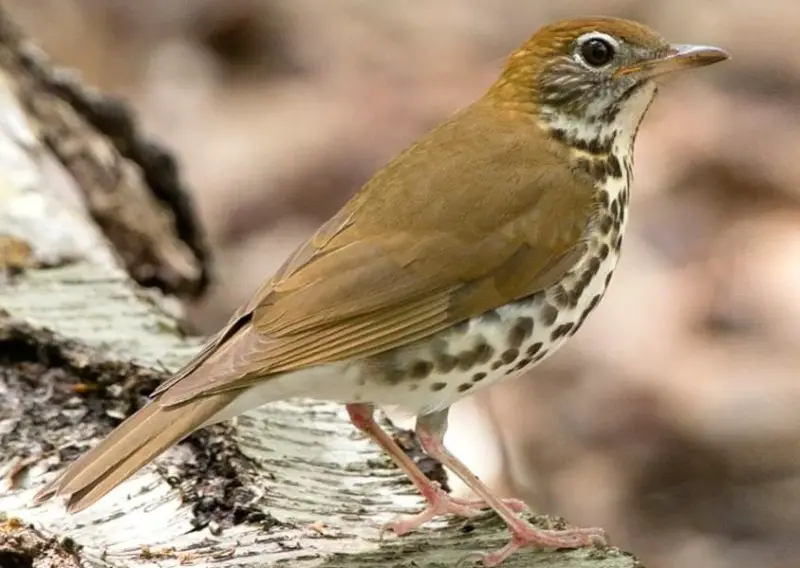
The Wood Thrush is a medium-sized forest bird with rich reddish-brown upperparts and boldly spotted white underparts. It has a short tail, large eyes, and a straight, slightly heavy bill. The back, wings, and crown are a warm chestnut brown, while the face shows a pale ring around the eye that gives it a gentle, alert look. Its black spots on the chest and flanks are one of its most striking features.
This bird is best known for its hauntingly beautiful song, a flutelike melody of layered tones that resonates through deciduous forests in the early morning and late evening. Wood Thrushes are secretive and prefer dense understory, where they forage on the forest floor for insects, snails, and leaf litter invertebrates. They also eat fruits and berries later in the season. Their cup-shaped nests are built in shrubs or saplings.
In Pennsylvania, the Wood Thrush is a widespread breeder in mature forests during spring and summer. It prefers moist woodlands with plenty of leaf litter and tall, shaded understory. As a flagship species for forest conservation, its presence is a sign of healthy woodland habitat. Its rich reddish-brown plumage and distinctive song make it one of the most admired thrushes in eastern North America.
Hermit Thrush (Catharus guttatus)

The Hermit Thrush is a small, understated bird with warm brown upperparts, a slightly reddish tail, and heavily spotted pale underparts. It has a slim bill, a white eye ring, and a soft, downcast expression. While similar in appearance to other thrushes, its rusty tail, which it often flicks, is a reliable field mark. It is slightly smaller and more compact than the Wood Thrush.
Known for its flutelike, ethereal song, the Hermit Thrush sings a series of clear, spiraling notes that many consider the most beautiful of any North American bird. However, in Pennsylvania, its song is heard mostly during spring and fall migration or in the state’s northern breeding areas. In winter, it often remains silent and is seen alone in wooded or brushy areas, sometimes foraging near logs and thickets.
Hermit Thrushes are regular migrants and winter visitors in Pennsylvania, especially in forests, parks, and sheltered natural areas. They forage by hopping on the ground, flipping leaves to find insects, berries, and other small foods. Although shy and quiet, their peaceful manner and haunting voice have made them a favorite among birdwatchers and poets alike.
Marsh Wren (Cistothorus palustris)
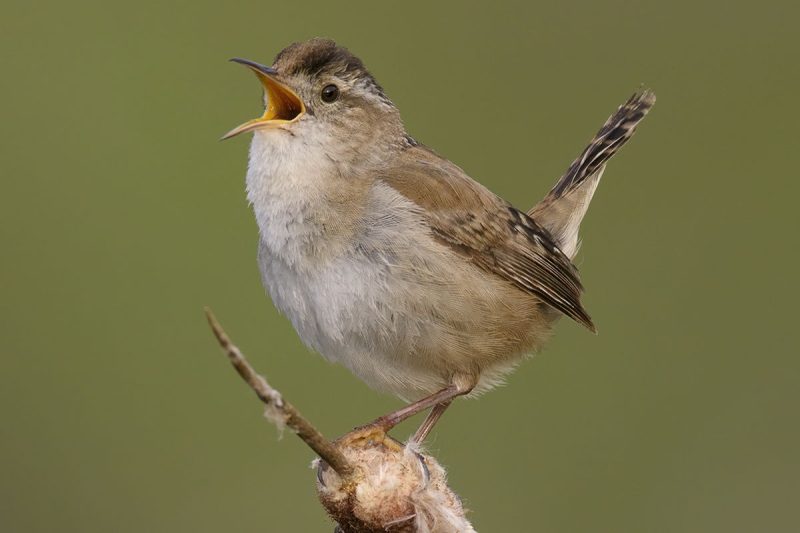
The Marsh Wren is a small, energetic bird with warm reddish-brown upperparts, a pale belly, and bold white stripes running down its back. It has a short bill, a faint white eyebrow, and a short, often cocked tail. Its plumage blends beautifully with the reeds and grasses of its preferred wetland habitat, making it difficult to see despite its active nature.
This species is most often heard before it is seen, delivering a loud, buzzy, gurgling song from deep within cattails or reeds. Marsh Wrens are highly territorial and aggressive toward intruders, often destroying the eggs or nests of other birds within their range. They build multiple dome-shaped nests woven into vegetation, using grasses and reeds to create secure, hidden structures.
In Pennsylvania, Marsh Wrens are found in suitable marshy habitats during the breeding season, especially in the northwest and southeast corners of the state. Though not as widespread as other wrens, they are locally common in large freshwater wetlands. Their constant motion, sharp calls, and preference for thick reeds make them fascinating to observe for those willing to spend time in the marsh.
Red-shouldered Hawk (Buteo lineatus)
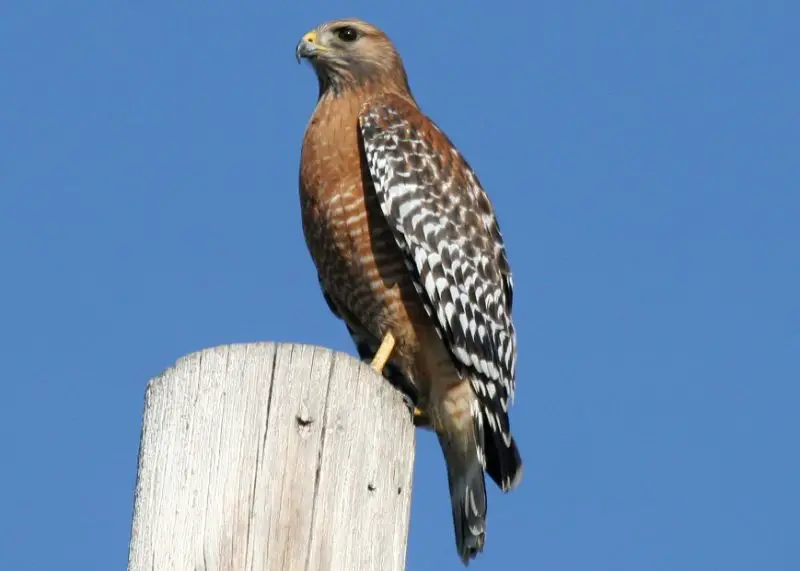
The Red-shouldered Hawk is a medium-sized raptor with striking reddish-brown coloring on its chest and shoulders, complemented by bold black and white banding on its wings and tail. Its head is brown with pale streaks, and it has sharp yellow eyes and a hooked beak. This hawk often perches prominently to scan for prey, making it relatively easy to spot.
It prefers mixed woodlands, river valleys, and swampy areas where it hunts small mammals, amphibians, and reptiles. The Red-shouldered Hawk is known for its distinctive, loud, and repetitive “kee-ah” call that echoes through forests. It builds large stick nests high in trees, reusing and adding to them year after year.
In Pennsylvania, this hawk is a year-round resident, especially common in eastern and southern parts of the state. It thrives near streams and wetlands, where its prey is abundant. Its reddish coloring and patterned wings distinguish it from other local hawks.
Northern Flicker (Colaptes auratus)

The Northern Flicker is a large woodpecker with a distinctive brown back covered in black spots, a barred tail, and a white rump patch visible in flight. It has a slightly curved bill and a black crescent-shaped patch on its chest. The head and face markings vary by subspecies, but in Pennsylvania, males often have a red or black “mustache” stripe.
Unlike many woodpeckers, Flickers often feed on the ground, using their strong bill to dig for ants and beetles. They also forage on trees, drilling holes and catching insects. Their call is a loud, ringing “wick-a-wick-a-wick,” and they often drum loudly on metal surfaces to communicate.
Northern Flickers are common year-round in Pennsylvania, found in woodlands, parks, and suburban areas. Their spotted brown back and distinctive calls make them familiar and easy to identify among local birds.
Northern Harrier (Circus hudsonius)
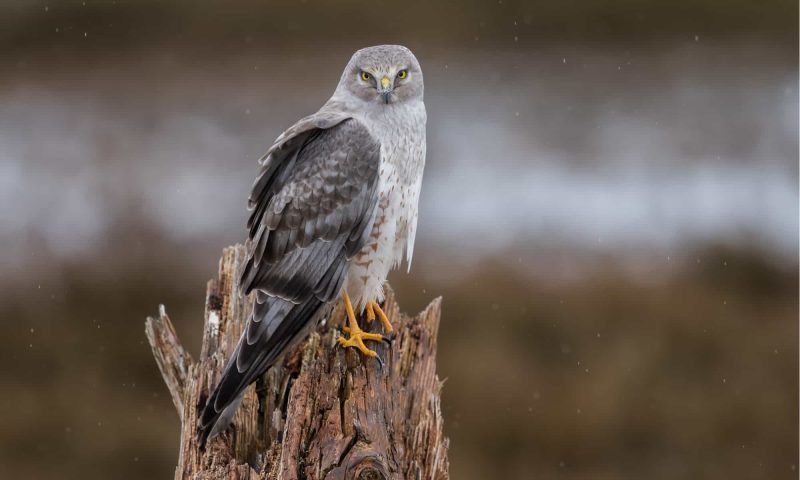
The Northern Harrier is a slim hawk known for its low, gliding flight over open fields and marshes. Females and juveniles are brown with streaked underparts, while males are gray. The female’s brown coloration features a mix of darker streaks and a white rump patch that is visible in flight.
This bird hunts by flying slowly and low over grasslands and wetlands, using its keen eyesight and hearing to detect small mammals and birds. It often nests on the ground in dense vegetation, camouflaged by its earthy plumage.
In Pennsylvania, Northern Harriers are most commonly seen during migration and winter, particularly in open farmland and marshy areas. Their distinctive flight style and white rump patch are key field marks. The brown females’ coloration helps them blend seamlessly into grassy habitats.
Brown Thrasher (Toxostoma rufum)
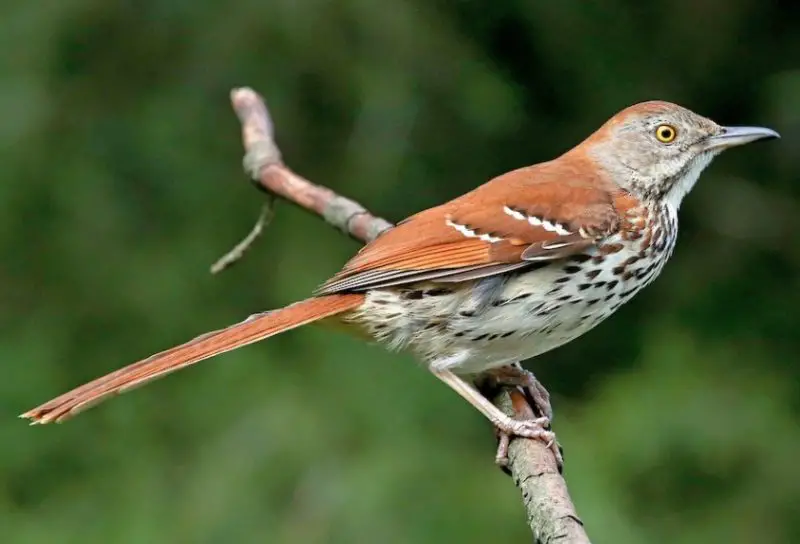
The Brown Thrasher is a striking songbird with rich reddish-brown upperparts, a long tail, and bright yellow eyes. Its underparts are pale with bold black streaks, giving it a patterned appearance. It has a slightly curved bill and is about 10 inches long, making it larger than most sparrows and wrens.
Known for its extensive song repertoire, the Brown Thrasher can sing hundreds of varied phrases, often repeating each twice. It favors dense shrubs and thickets where it forages on the ground for insects, berries, and seeds by flipping leaves and debris. It builds cup-shaped nests low in bushes or small trees.
In Pennsylvania, Brown Thrashers are common summer residents in shrubby habitats, woodland edges, and suburban gardens. Their reddish-brown coloration and loud, melodic singing make them easy to detect, even when hidden in dense brush.
Purple Finch (Haemorhous purpureus)
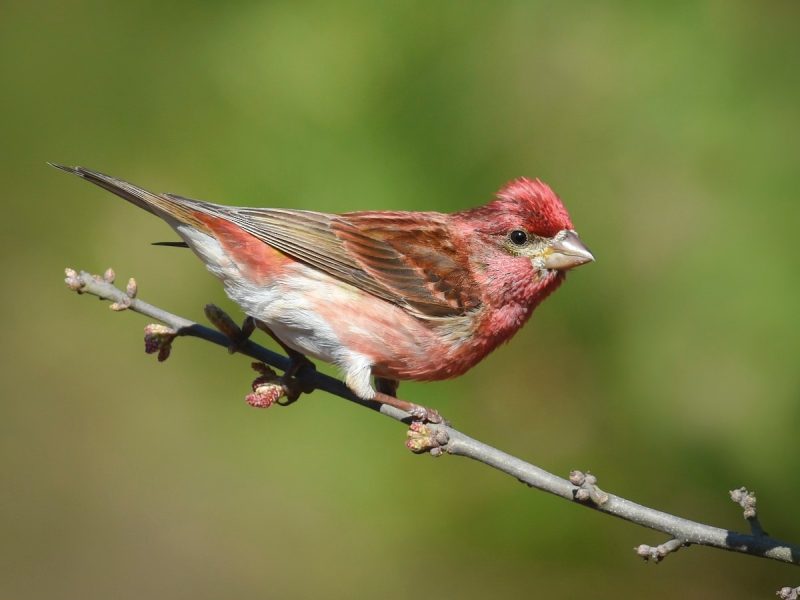
The Purple Finch is a medium-sized finch with a conical bill and a slightly rounded head. Males are rose-red overall, but females have brown streaky plumage that is somewhat similar to House Finches but usually less streaked on the breast and with a warmer, richer brown tone.
Females feed on seeds, berries, and insects, often visiting feeders in wooded suburban areas. They have a pleasant warbling song and a sharp “chip” call. Purple Finches are somewhat shy and prefer mature coniferous and mixed forests for breeding.
In Pennsylvania, Purple Finches are less common than House Finches but are regular visitors during migration and winter. The females’ warm brown streaked feathers help them blend into forest edges and backyard trees, though they are less frequently seen than their colorful male counterparts.
Red-tailed Hawk (Buteo jamaicensis)
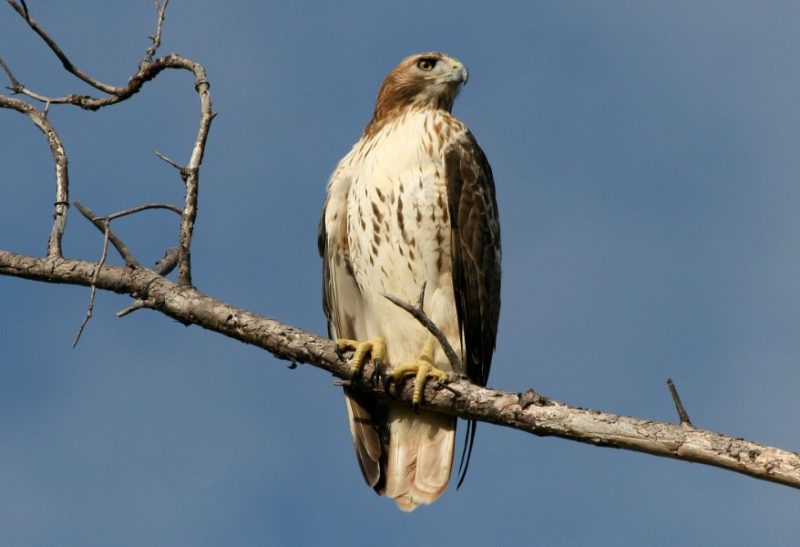
The Red-tailed Hawk is a large, robust raptor with a broad, rounded tail that is often brick-red on the upper side. Its back and wings are brown, while the underside is lighter with streaks. The head is relatively large with a hooked beak and keen yellow eyes. It is one of the most widespread and recognizable hawks in North America.
This bird of prey prefers open habitats such as fields, deserts, and road edges, where it soars high or perches prominently on trees or poles to scan for prey like rodents, rabbits, and birds. Its iconic scream-like call is frequently heard in movies and nature films. The Red-tailed Hawk builds large nests high in trees or on cliffs and reuses them annually.
In Pennsylvania, the Red-tailed Hawk is very common year-round and thrives in both rural and suburban areas. Its brown back and unmistakable red tail make it easy to identify even at a distance.
White-crowned Sparrow (Zonotrichia leucophrys)
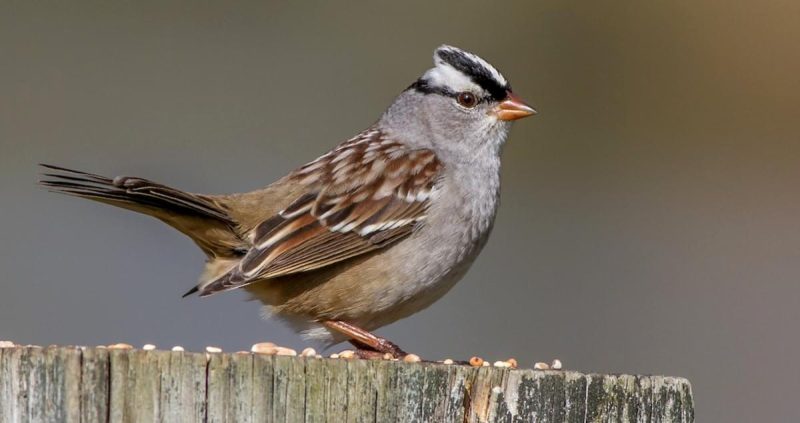
The White-crowned Sparrow is a medium-sized sparrow that visits Pennsylvania mainly in winter. Its most distinctive feature is the striking black and white stripes on its crown, contrasting with a soft brown back and grayish underparts. The bill is pinkish, and the legs are pale.
This sparrow favors open woodlands, brushy fields, and suburban areas with dense shrubs. It feeds primarily on seeds and insects on or near the ground. Its clear, whistled song and sharp calls are common sounds in winter landscapes. The White-crowned Sparrow is often seen in flocks with other sparrows.
In Pennsylvania, this species is a regular winter visitor, occasionally seen during migration. Its bold head stripes and contrasting coloration make it fairly easy to distinguish from other sparrows.
Lincoln’s Sparrow (Melospiza lincolnii)
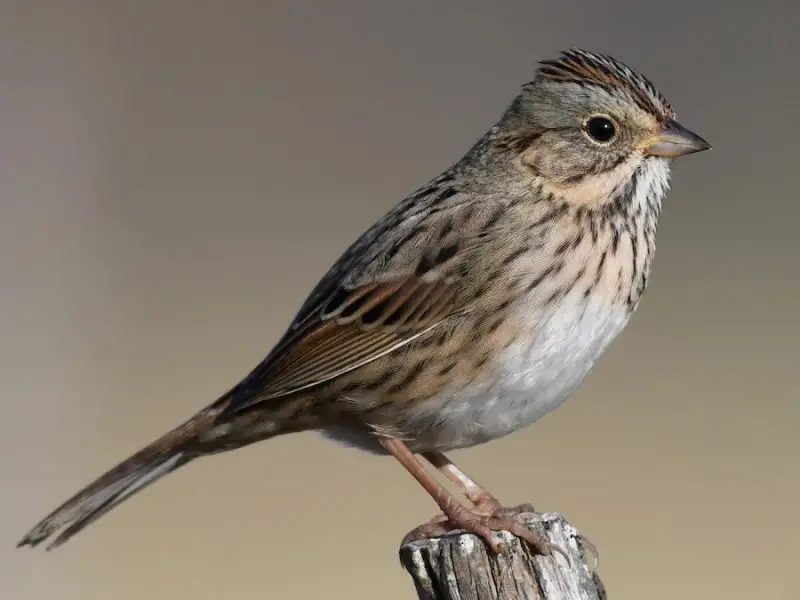
Lincoln’s Sparrow is a small, secretive bird resembling the more common Song Sparrow but generally less abundant. It has finely streaked brown upperparts and underparts with a buffy wash on the chest and a delicate, slim bill. Its face has a subtle, soft pattern with a pale stripe over the eye.
This sparrow prefers dense thickets, shrubby wetlands, and brushy edges, often remaining hidden in thick cover. It feeds on seeds and insects, foraging on the ground or low vegetation. Its song is a sweet, musical trill that is softer and more complex than many other sparrows.
In Pennsylvania, Lincoln’s Sparrow is an uncommon migrant, seen primarily during spring and fall. Its shy behavior and subtle plumage can make it a challenge to spot, but its delicate song often reveals its presence.
Golden-crowned Sparrow (Zonotrichia atricapilla)
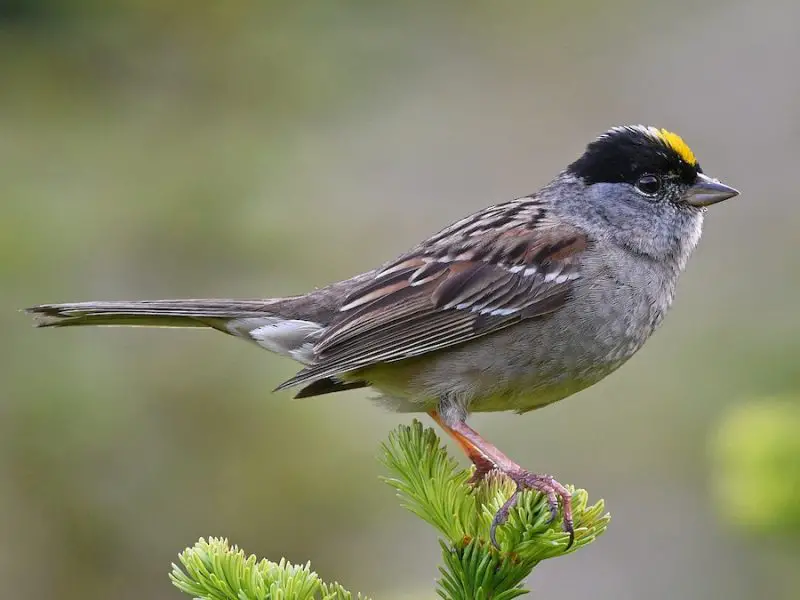
The Golden-crowned Sparrow is a rare and irregular visitor to Pennsylvania, typically appearing during winter months. It has a distinctive golden-yellow patch on the crown bordered by black, contrasted against warm brown back feathers and pale underparts.
This sparrow generally inhabits brushy areas and forest edges, feeding on seeds and berries mostly on the ground. It is more common on the west coast of North America, so its appearance in Pennsylvania is considered unusual and exciting for birdwatchers.
When present, the Golden-crowned Sparrow’s clear, musical whistles and bright head markings make it stand out among other sparrows. Due to its rarity in the region, any sightings tend to attract birding attention.
Rusty Blackbird (Euphagus carolinus)
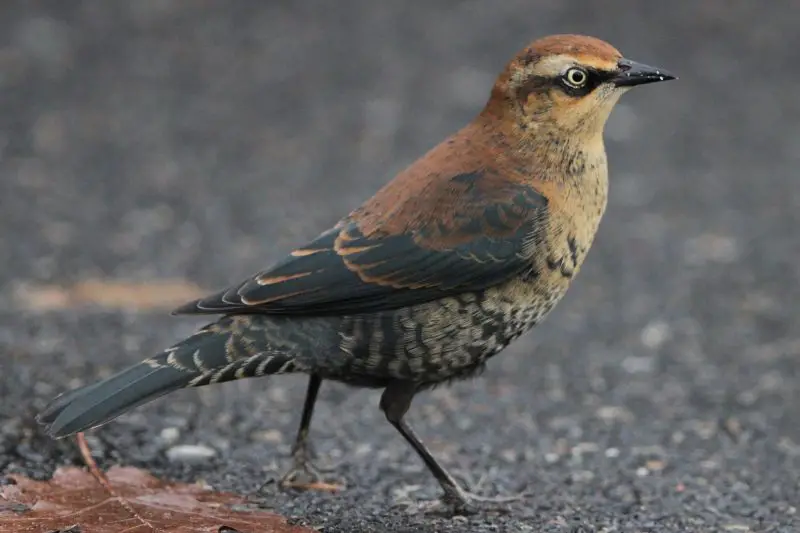
The Rusty Blackbird is a medium-sized blackbird with males in breeding plumage showing iridescent black feathers, while females and non-breeding birds appear brownish with rusty tones on the edges of their feathers. It has a slender bill and bright yellow eyes.
This species favors wet, swampy forests, wooded wetlands, and flooded areas where it forages for insects, seeds, and small aquatic animals. Rusty Blackbirds are often found in flocks during migration and winter, sometimes mixed with other blackbirds.
In Pennsylvania, Rusty Blackbirds are mainly winter visitors and migrants. Their rusty-brown female plumage and preference for wet habitats make them somewhat easier to identify than other blackbirds, especially when seen in groups near marshes or flooded woodlands.

